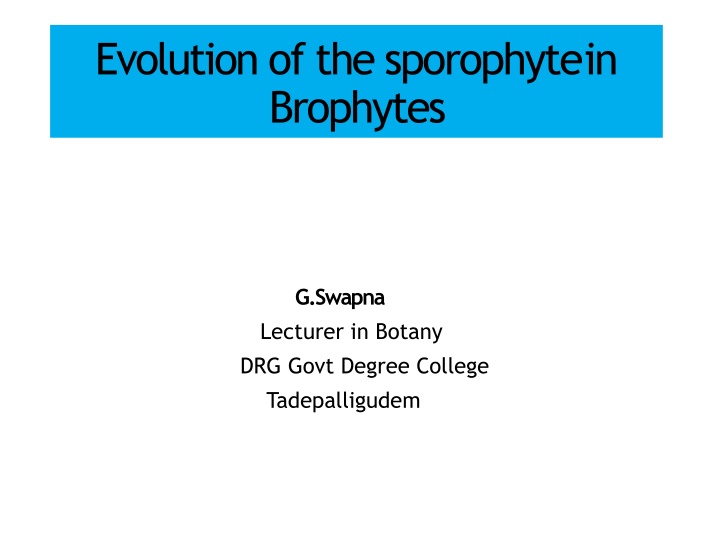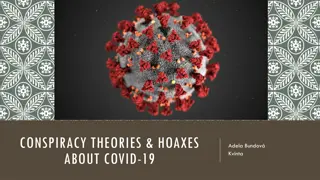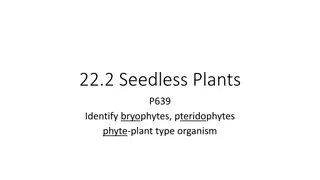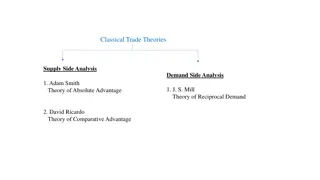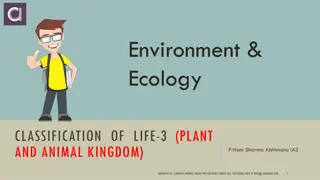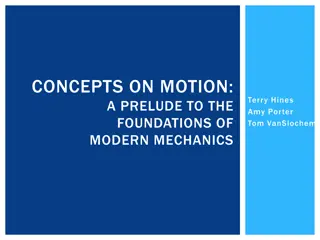Evolution of the Sporophyte in Bryophytes: Theories and Stages
The evolution of sporophytes in bryophytes like liverworts and mosses follows two main theories - progressive sterilization and reduction. The progression of sporophytes from simpler forms like Riccia to more complex forms like Sphagnum is discussed, highlighting the stages of development such as the presence of foot, seta, capsule, and sterile tissues. The "Theory of Sterilization" proposes that complex forms evolved from simpler ones due to progressive sterilization of fertile tissues. Several stages of sporophyte development in bryophytes are outlined, illustrating the structural changes that took place over time.
Download Presentation

Please find below an Image/Link to download the presentation.
The content on the website is provided AS IS for your information and personal use only. It may not be sold, licensed, or shared on other websites without obtaining consent from the author.If you encounter any issues during the download, it is possible that the publisher has removed the file from their server.
You are allowed to download the files provided on this website for personal or commercial use, subject to the condition that they are used lawfully. All files are the property of their respective owners.
The content on the website is provided AS IS for your information and personal use only. It may not be sold, licensed, or shared on other websites without obtaining consent from the author.
E N D
Presentation Transcript
Evolution of the sporophyte in Brophytes G.Swapna Lecturer in Botany DRG Govt Degree College Tadepalligudem
Content Introduction Theory ofSterilization ReductionTheory
Introduction Thesporophyteofliverwortsandmossesshowmostlythe same fundamentalplan. Itismadeupofananchoringandabsorbingfoot,astalk-like setaandacapsule,whichcontainssporesandelaters. The following two contrasting views have been putforword withregardtotheevolutionofsporophytesinbryophytes:- 1. Evolutionofsporophytesbyprogressivesterilizationof potential sporogenoustissue. 2. Evolutionofsporophyteduetoprogressivereductionor simplification.
Theory ofsterilization SporogenousTissue:- This view , also known as 'theory ofprogressive evolution 'or 'theory of sterilization ',was put forward by Bower(1908-35)and supported by cavers (1910) and Campbell(1940). According to thisview,the sporophytesof complex forms (e.g.,Funaria,Sphagnum ,Pogonatum) have evolved due to progressive sterilization of thepotentialfertile tissue ofthe simplerforms(e.g.,Riccia, Marchantia).
Firststage The simplest known sporophyte amongBryophtes is that ofRiccia. In all species of Riccia ,the sporophyte consists of only capsule ,there being no traceof seta andfoot. The oospore ( the mother cell of the sporophyte ) dividesfirst by a transverse and then by a vertical wall to form a four - celled embryo which becomes 20-30 celled by furtherdivision . Occasionally , a few cells failto develop into spores and these sterile cells( nurse cells) have nutritive function and are supposed to be the ancestors ofelaters.
SecondStage In Corsinia , the oospore divides by a transverse wall into a hypobasal andan epibasalcell. The former gives rise to a smallfoot. The derivatives of the epibasal cell froman outer amphithecium and an inner endothecium. Thus in the sporophyte of Corsinia the sterilization has gone a step further and in additiontonursecells,asterilefootisalso present.
ThirdStage Further sterilization is seen in spharocarpus where the sporophyte has a sterile bulbous foot and a narrowseta, in addition to fertile capsule. The amphithecium forms a singlelayered jacket of the capsule and theendothecium ,the sporogenous tissue and thesterile nursecells.
ForthStage In Targionia,the sporophyteis differentiated into a bulbous foot ,a massive seta and a capsule. The amphithecium gives riseto a single layered jacket of the capsule and only about half of the endothelial cells give rise to fertile sporogenous tissue and the remaining half form sterileskaters. Thus in the sporophyte of Targionia there is still further sterilization of sporogenous tissue in comparison to Riccia,Corsinia,Sphaerocarpus.
FifthStage In Marchantia , the lower half (hypobasal cells) of theoctant embryo froms the foot,and seta and the upper half (epibasal cells ) thecapsule. Approximately 50 percent of the sporogenous cells form spores and the remaining 50 percent elaters with characteristic thickeningbands. Thus,a bulbous foot,an elongated seta , a single layered capsule wall andlarge number of elaters are sterile constituents of the sporophytes ofMarchantia.
SixthStage Further sterilization of the sporophytic tissue canbeseeninPellia. The sporophyte of Pellia is also differentiated into foot,seta and capsule as inMarchantia but the jacket of the capsule is two or more layered. Furthermore , a fixed sterile elaterophore is present at the proximal end of the capsule with a bunch ofelaters.
SeventhStage The sporophyte of Anthoceros is of great interest from the pointof view of evolution. The mature sporophyte consists of a bulbousfoot and horn or bristle -like capsule. The elaters of Anthoceros are known aspseudoelaters as they do not possess thickeningbands. Thus , from the point of view of sterility and self- dependence , the sporophyte of Anthoceros is more specialized than those of Hepaticopsida.
EighthStage The highest degree of sterilization of the sporophyte is foundin the classBryopsida. The regions likefoot, seta,capsule wall, columella,apophysis ,operculum and peristome inthe Bryophyta. Funaria,Politrichumand Pogonatum represent the steriletissue.
Thus the sporophyte of Riccia is the simplest amongst the bryophytes, with a very high proportion of fertile tissueandthe sterile tissueis verysmall. On the other hand , the members of the class Bryopsida (e.g.,Funaria,Polytrichum , Pogonatum ) have the most complex sporophyte with a veryhigh degree ofsterility. The evolution ofsporophytein bryophytes assuch is considered to have taken place by progressive sterilization of the fertile tissue.
ReductionTheory There is however, an -opposite school of thought led by Kashyap,Church,Goebeland Evans. They hold that so serlated the evolution of the sporophyte has been in the downwarddirection . The series they believe furnishes an exampleof retrogressiveevolution. There is ample evidence of reduction rather than progressive elaboration of thesporophytes of thisgroup.
The significant steps inthe reduction seriesare:- 1. Simplification of the dehiscenceapparatus. 2. Reduction of the greenphotosynthetic tissue in the capsulewall. 3. Associated with the above is the disappearance of stomata andintercellular spaces.
Side by side with the above changes in the gradually elimination of the seta and subsequently the disappearance of thefoot. All these changes are accompanied bythe progressive increase in the fertility of the sporogenouscells. Evidence fromcomparativemorphology and experimentaly genetics support the view that thesimplesporophyte of Riccia is anadvanced but a reducedstructure.
Reference Botany For Degree Students Bryophytes by:- B. R.Vashistha A.K.Sinha V . P .Singh https://en.m.wikipedia.org https://www.slideshare.net
